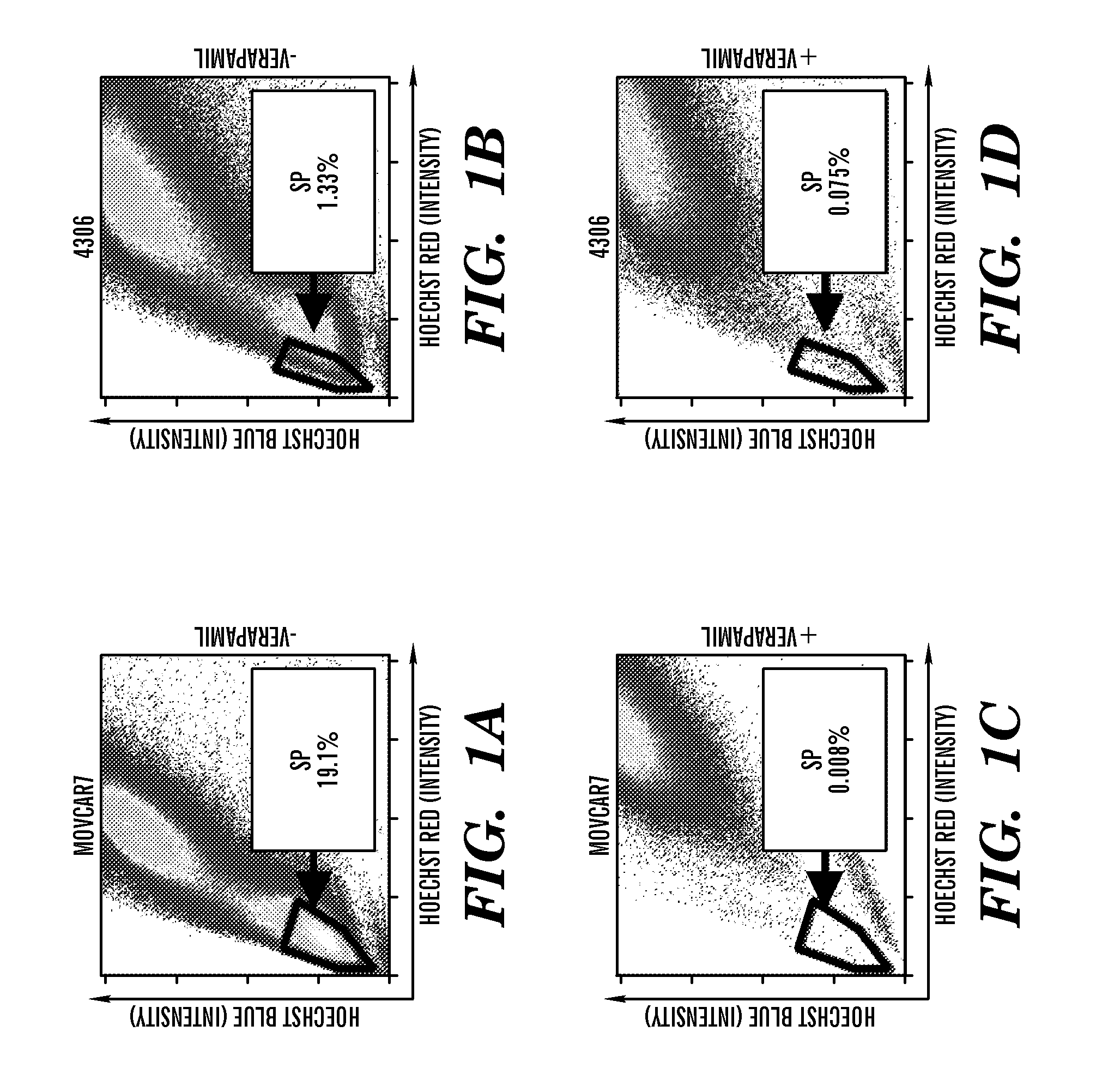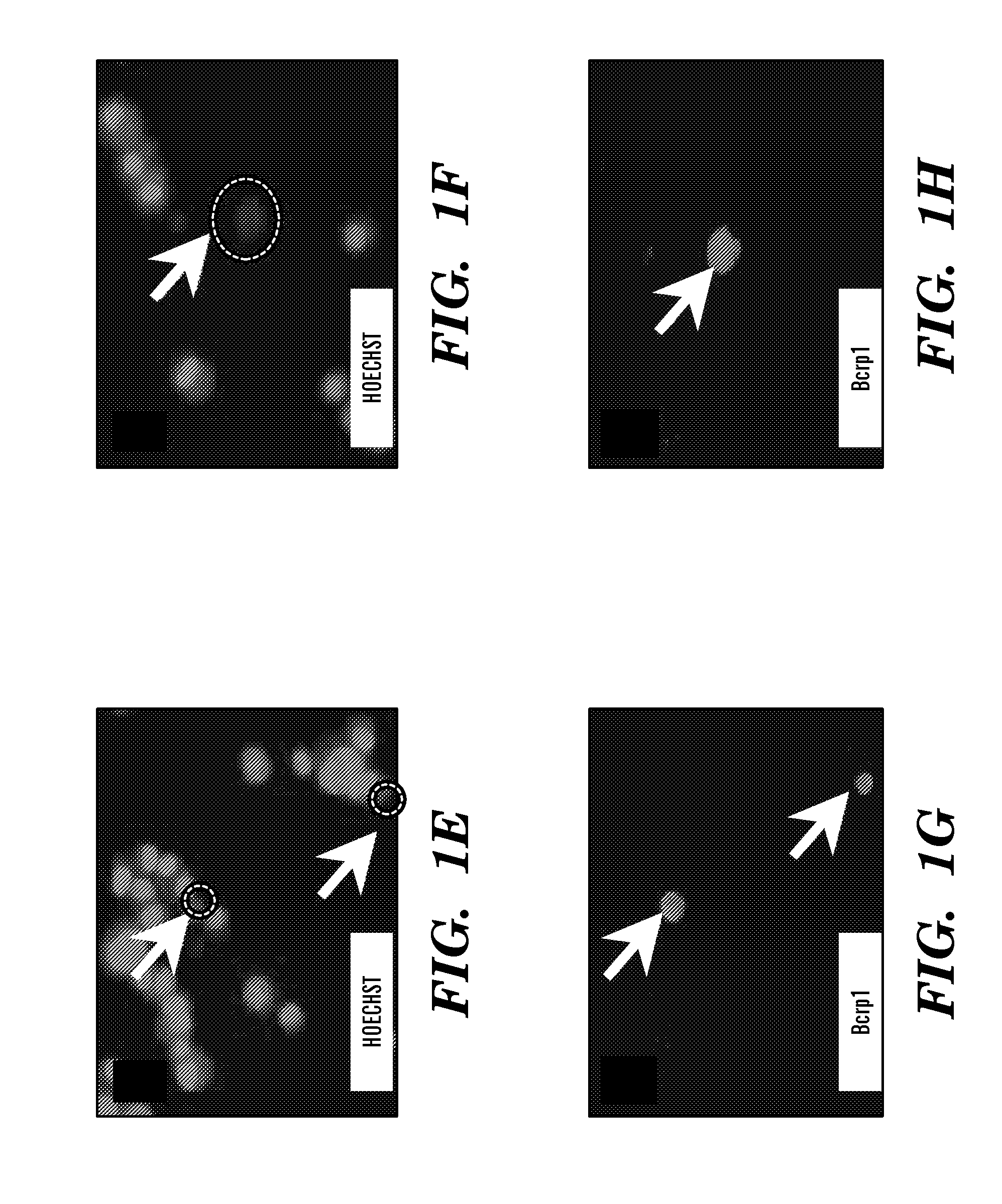Methods to identify and enrich for populations of ovarian cancer stem cells and somatic ovarian stem cells and uses thereof
a technology which is applied in the field of methods to identify and enrich populations of ovarian cancer stem cells and somatic ovarian stem cells, can solve the problems of rarely a cure, and achieve the effects of reducing inhibiting the self-renewal capacity of an ovarian cancer stem cell, and reducing the proliferation
- Summary
- Abstract
- Description
- Claims
- Application Information
AI Technical Summary
Benefits of technology
Problems solved by technology
Method used
Image
Examples
example 1
[0263]Identification of SPs in Mouse Ovarian Cancer Cell Lines. To determine whether mouse ovarian cancer cell lines contain candidate cancer stem cells, Hoechst 33342 was used to sort for the SP phenotype. The serous adenocarcinoma-recapitulating MOVCAR 7 and 8 cell lines were developed by using the MIS type II receptor (MISRII) promoter to drive the SV40 T antigen (19). The endometrioid carcinoma-recapitulating 4306 cell line was developed from conditional LSL-K-rasG12D / + / PtenloxP / loxP mice in which the ovarian surface epithelium was infected with adenovirus expressing Cre recombinase (20). Flow cytometry demonstrated a very high percentage of HoechstLow SP cells in the MOVCAR 7 and 4306 cell lines (FIGS. 1A and B), whereas SP was not detected in MOVCAR 8. Verapamil, a BCRP1 inhibitor (18), effectively eliminated the SP in both MOVCAR 7 and 4306 cells (FIGS. 1C and D). The average first sort percentage of SP cells was 6.28% (n=6) for MOVCAR 7 and 1.83% (n=4) for 4306 cells, which ...
example 2
[0264]Ex Vivo Growth of SP and NSP Cells. Growth characteristics of the SP and NSP cells were consistent with previous findings for cancer stem cells (21). MOVCAR 7 and 4306 cells were sorted by flow cytometry and equal numbers of SP and NSP cells cultured. SP cells from both cell lines formed characteristic compact circular colonies with a cobblestone appearance and survived numerous passages (FIGS. 2 A and C; n=9). NSP cells from both cell lines were sparse and failed to proliferate beyond 1-2 weeks (FIGS. 2 B and D; n=9). These differences were not a consequence of prolonged Hoechst retention in the NSP cells because propidium iodide was used to gate out all nonviable cells. Serial sorting and reanalysis (total passages=3) of SP cells demonstrated enrichment of the SP and the presence of NSP cells (FIG. 2 E-J), suggesting asymmetric division occurred during culture (FIG. 2 F, G, I, and J). Thus, SP cells are able to self-renew, be enriched, and produce NSP cells when recovered an...
example 3
[0265]SP Cells Are in G1 Cell Cycle Arrest and Resistant to Doxorubicin in Vitro. By definition, SP cells should express high levels of BCRP1 and thus be able to efflux the lipophilic dye Hoechst 33342 and some lipophilic anticancer drugs, including those used in the treatment of ovarian cancer (18, 22). The lipophilic anticancer drug doxorubicin is a substrate of the BCRP1 transporter, whereas the lipophilic microtubule inhibitor paclitaxel is not (23). To investigate the functional significance of the Bcrp1 transporter found in MOVCAR 7 SP cells, we tested their response to doxorubicin and paclitaxel, as compared with that observed in the NSP, by methylthiazoletetrazolium (MTT) proliferation assays (FIG. 3). MOVCAR 7 SP cells were only inhibited by 30% after treatment with doxorubicin, whereas the NSP cells showed 81% inhibition (FIG. 3A). In contrast to doxorubicin, MOVCAR 7 SP and NSP cells were almost equally inhibited by the Bcrp1-resistant paclitaxel (FIG. 3B; SP=85% inhibiti...
PUM
| Property | Measurement | Unit |
|---|---|---|
| Lipophilicity | aaaaa | aaaaa |
Abstract
Description
Claims
Application Information
 Login to View More
Login to View More - R&D
- Intellectual Property
- Life Sciences
- Materials
- Tech Scout
- Unparalleled Data Quality
- Higher Quality Content
- 60% Fewer Hallucinations
Browse by: Latest US Patents, China's latest patents, Technical Efficacy Thesaurus, Application Domain, Technology Topic, Popular Technical Reports.
© 2025 PatSnap. All rights reserved.Legal|Privacy policy|Modern Slavery Act Transparency Statement|Sitemap|About US| Contact US: help@patsnap.com



